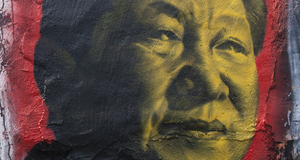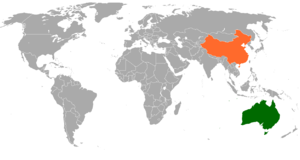Spectrums of Nationalism: A Comparison of American and Chinese Nationalism
By
2016, Vol. 8 No. 09 | pg. 1/1
IN THIS ARTICLE
American media generally depicts nationalism as a negative concept, which is threatening to peace and security. However, in its broadest sense, nationalism can incorporate two phenomena: “(1) the attitude that the members of a nation have when they care about their identity as members of that nation and (2) the actions that the members of a nation take in seeking to achieve (or sustain) some form of political sovereignty.”1 Neither of these is inherently threatening to either peace or security. Why, then, is Chinese nationalism so often viewed as a threat? I propose that this perception comes from the fact that American and Chinese nationalism are two extremely different beasts. As American nationalism has developed into a “universalist” set of values, any standards that do not align with the United States’ “universal” principles cause tension. On the other hand, Chinese nationalism integrates the morals of Chinese culture, in turn boosting the national and cultural identity. Both nationalist ideologies possess distinctive characteristics and may have impacts on foreign policy. This paper attempts to concisely define American and Chinese nationalismi and compares the qualities of each incarnation. American NationalismAs an American, defining the values of our nationalist ideology is quite easy, as it is constantly embedded in our media. If limited to five themes, I would predict that many Americans would define the United States’ nationalist values as the following:
These ideological themes are fairly broad in the sense that none of the above aspects have anything to do with a specific cultural or ethnic identity. The reasoning behind such a development may come from the fact that, excluding the Native American tribes, all Americans are immigrants and hence the United States does not have an “ethnic identity,” but I digress. Many Americans believe such themes to be universally applicable.ii Such beliefs are illustrated in the fact that the United States often tries to promote these ideals in its foreign policy. These “universal” values are very prevalent in American foreign policy. An occasion of this belief is the rationale behind both the Iraq and Afghanistan Wars. Multiple provocations for military involvement in Iraq were cited in the United States’ Iraq Resolution of 2002; among the many motives quoted were ending human rights violationsiii and installing a democratic government.2 Likewise, while the United States did not directly reference any of the previously mentioned nationalist values when justifying the invasion of Afghanistan, in George W. Bush’s 2003 Veteran’s Day address, an unofficial rationale for both wars was conferred:
The sentiment that United States nationalist values are deemed “universal” is unmistakably prevalent in the rationales for intervention in both Iraq and Afghanistan. Not only are the values directly mentioned in the official rhetoric - they are unceasingly used as a justification for involvement. Chinese NationalismUnlike American nationalism, Chinese nationalism seems to have much more domestically-focused tendencies, such as:
While these themes do not tie together a cultural or ethnic identity, it is distinctive from my definition of American nationalism.iv Here, a key point in my definition of Chinese nationalism is the “Non-Interference in Other Nations’ Internal Affairs.” While not directly contrary to the United States’ nationalism, it is a foundational difference in terms of international involvement. We see these values in China’s commitment to “never seek hegemony,” which, in the modern global arena, is meant as a message that China will never attempt to become a regional aggressor and thus will respect the sovereignty and territorial integrityv of other nations in the region.3 Moreover, oftentimes China will cast an abstention vote when the United Nations is deliberating on resolutions involving mandates or interventions in the internal concerns of other nations. By casting this abstention vote, China is showing commitment to the nationalist value of non-interference. In addition to the three internationalist points, I would like to add two final identifiers of Chinese nationalism that are important to include:
As a developing nation, China must always take into account its economic development as a nationalist staple. Economic development is crucial not only to the nation, but to the legitimacy of the Chinese Communist Party (CCP) and thus can be considered a nationalist theme that impacts foreign policy. Interestingly, economic development is the one remotely similar aspect of both the American and Chinese definitions; this may help illuminate why both nations try to keep cordial relations.vi Furthermore, China’s national history is incorporated because, multiple times throughout the history of Chinese foreign policy, historical events have been used to fan nationalist fervor. Moreover, events in history have been cited as reasoning behind foreign policy decisions. China’s official relationship with Japan is one such instance where national history has impacted foreign policy. Strained by the historical blemish of wartime incidents, Sino-Japanese relations have been frequently discussed by foreign policy experts. Discussion: Disparities in NationalismWhen we examine each nation’s designation of nationalism and compare, we see some fascinating differentiations. For reference in the comparison, the two five-point definitions are listed below:
These incarnations of nationalism are very different beings. As stated previously, we see an essential difference in terms of international applicability. With the United States, we see a moral, ethics-based nationalism with values that are considered “universal.” Almost by definition, American nationalism requires international involvement in any nation’s internal affairs that are inconsistent with its values. Instances such as the United States’ intervention in Haiti after the 1991 military coup are illustrative of the obligation that “universal” nationalism appears to position on the United States.4 If the United States had not become involved in circumstances like those formerly cited, queries of commitment to its “universal” nationalistic values would have likely emerged.vii Conversely, nationalism for China holds an emphasis that is inherently localized or personalized for China’s contemporary developmental setting. Hence, there is no global function for present-day Chinese nationalism because China will not become involved, even if it may not agree with another nation’s internal affairs. As previously mentioned, casting an abstention vote in the United Nations is illustrative of the non-interventionist value being a major factor in China’s nationalism. The dissimilarity concerning American “universal” nationalism and Chinese “domestic” nationalism, as Stephen Harner observes, is illustrated as a consequence of the institutional polarity between the U.S. Department’s Bureau of Democracy, Human Rights, and Labor and China’s Confucius Institutes.5 Although both are clearly tied to each nation’s government, the utility of both organizations is noticeably different. The U.S. State Department’s Bureau of Democracy, Human Rights, and Labor’s homepage introduces the bureau by stating:
Additional enquiry about the Bureau reveals The Human Rights and Democracy Fund (HRDF). The HRDF was established during FY1998 and funding has grown from $7.82 million in FY1998 to over $207 million in FY2010.6 The HDRF section of the Bureau’s website presents the fund in the following manner:
The language articulated in the depictions of both the Bureau and the HDRF is quite fascinating. At the very beginning readers of the description learn that the foundational basis of the United States’ foreign policy is to promote its values; subsequently, the introduction of the Bureau recurrently asserts that the United States’ job is to work with other nationsviii to further promote these deeply held values. Unquestionably, one can gauge from this solitary introduction that the United States judges its nationalist values to be universal. Such a judgment is capable of being formed owing to the reality that the United States believes it is a necessity to internationally promote the “universal” values of democracy, human rights, freedom of speech, religious freedom and free enterprise. Nevertheless, greater analysis of the HDRF’s introduction exposes additional noteworthy lines of reasoning. Based on the description above, readers have a vague understanding of how the HDRF really operates. The notion of politically sensitive, groundbreaking and cutting-edge programs that result in dramatic effects on promoting democracy, does not reveal copious amounts of information. However, when paired with the concept that the United States’ nationalism is “universal,” and that it is the United States’ job is promote the nationalist values internationally; a better understanding about the function of the HDRF is discovered. At its essence, the HDRF is a fund meant to actively pursue intervention in the internal concerns of other nations. Not only do the aforementioned introductions exemplify that the United States believes that its nationalist values are indeed universal, they furnish a vivid juxtaposition to the presentation of both China’s Confucius Institutes and the Hanban, the institution responsible for the organization of China’s Confucius Institutes:
The contrast to the institutional description of the U.S. Department’s Bureau of Democracy, Human Rights, and Labor and its HDRF could not be greater. Whereas the descriptions of the American institutions describe promoting nationalistic values across the world, the Chinese institutional portrayals are much more along the lines of China’s peaceful development, and not once are any of the nationalistic values mentioned. The wording in both introductions is affirmative and develops an overall positive promotion of the Confucius Institutes and its organizing body. Interestingly enough, the descriptions of these Chinese institutions upholds the notion of “Non-interference in Other Nations’ Internal Affairs.” Non-interference, in theory, ought to allow for nations to independently develop, thus constructing a more multicultural world. That being said, the Hanban helps contribute to the expansion of multiculturalism in the world, so it could be said that China’s Confucius Institutes are an outcome of their non-interventionism. Undoubtedly, the U.S. Department’s Bureau of Democracy, Human Rights, and Labor and China’s Confucius Institutes are organizations which could conceivably be utilized to elevate the international persona of each nation and be used as a strategic influence internationally. Nonetheless, the process by which the institutes endorse the image is exclusively essential in this instance. For the United States, we would almost certainly see a widely interventionist promotion, while for the Chinese, a non-interventionist promotion through culture and language would be quite probable. Obviously these approaches could be modified as time progresses; and in turn, the global, foreign policy ecosystem would correspondingly be influenced by either country’s deeds. The crucial variance between the international operations of nationalism for these two nations is quite fascinating. The difference spurs an idea that, when compared to Chinese nationalism, American nationalism may be intrinsically prone to developing enemies internationally. By possessing a “universally applicable” nationalism, the United States becomes an interventionist nation. This makes it much more likely for nations that do not align with the values of American nationalism to at least be unfriendly towards the United States because these nations will not want the United States to become involved with their internal affairs. Russian-American relations are one case of unfriendly interactions that have sometimes been further soured by the American “universal” nationalism. Whenever Russia acts in a way that the United States does not agree with, the United States will, in turn, react, placing sanctions against Russia. While it can be debated whether or not some of Russia’s actions are “internal affairs,” the United States feels compelled to intervene regardless. Accordingly, there is much negative sentiment towards the United States, prompting many Russian government officials, like Vladimir Putin, to make undesirable statements about the United States and its role in the world.7 It could even be said that the United States’ “universal” nationalism has sometimes prompted tense relations between China and the United States, as observed with the United States’ criticisms of China’s human rights violations. Regardless of the fact that the United States has not directly intervened with China’s internal affairs, funds like the previously mentioned HDRF have subsidized many non-governmental organizations (NGOs) to become involved in China, attempting to influence internal affairs.8 ConclusionNationalism, while not inherently threatening to the peace and security of other nations, can be developed into a set of values that represents a nation’s concern for its existing situation. It can encourage international intervention and even contain a non-interventionist emphasis. Through the formulation of definitions of nationalism for China and the United States, two very different nations, we discovered the aspects of nationalism to which each nation attempts to adhere when making foreign policy decisions. On one hand, with the United States, we see much more “universal” values, containing an ethical and moral basis. More or less, the values of democratization, human rights, freedom of speech, religious freedom, and free enterprise intrinsically bind the United States to an interventionist approach on the international stage. Such an obligation can be detected when considering the functions of American institutions, such as the U.S. Department’s Bureau of Democracy, Human Rights, and Labor and the HDRF. Both the Bureau and the HDRF are designed to observe other nations and, when needed, promote the values of American nationalism abroad. Such “universal” values bringing forth interventionist institutionalization, has resulted in American nationalism being more prone to developing enemies. On the other hand, we observe a Chinese nationalism with much different characteristics. Domestically focused, the nationalism in China is not comprised of values that encourage international intervention; in fact, it does the opposite. Chinese nationalism encompasses a respect for sovereignty, territorial integrity, non-interference in other nations’ internal affairs, economic development, and national history. These values, as stated, have a domestic emphasis that encourages China to take a stance of non-interference in the international arena. Consequently, Chinese institutions like the Confucius Institutes follow a very similar model, highlighting the progression of friendship and multiculturalism as the main function. It is without a doubt that the U.S. Department’s Bureau of Democracy, Human Rights, and Labor and China’s Confucius Institutes can be utilized as a strategic tool for international involvement; however, the distinction between the methods both institutions utilize is the more important line of reasoning to concentrate on analyzing. China’s circumstance is much more positive, emboldening friendship and cooperation between China and the rest of the world. In the United States’ case, we see an institution that is interventionist in other nations, employing “politically sensitive” methods that can produce “dramatic” results.9 These “universal” values of nationalism for the United States may have worked in a unipolar world, where any nation that spoke out against the hegemony was seen as a challenger. Yet, in an endlessly developing world, it appears more and more probable that this model of nationalism is doing more harm than good – for both the United States and other nations in the world. ReferencesAbout Confucius Institute/Classroom. (n.d.). Retrieved December 24, 2015, from http://english.hanban.org/node_10971.htm Appendix A: Universal Declaration of Human Rights. (n.d.). Retrieved December 22, 2015. Bureau of Democracy, Human Rights, and Labor. (n.d.). Retrieved January 16, 2016. China Dismisses Intent for Hegemonic Role in World Affairs. (n.d.). Retrieved December 19, 2015, from http://www.worldaffairsjournal.org/content/china-‘we-will-never-seek-hegemony’ DRL Programs. (n.d.). Retrieved December 24, 2015. Gordts, E. (2011, October 1). Vladimir Putin, Russian Prime Minister, Calls U.S. Parasite On The Global Economy. Retrieved December 24, 2015 Hanban-AboutUs. (n.d.). Retrieved December 24, 2015, from http://english.hanban.org/node_7719.htm Harner, S. (2015, June 4). American Universalism vs. Chinese Nationalism. Retrieved December 24, 2015. Joint Resolution to Authorize the Use of United States Armed Forces Against Iraq. (2002, October 2). Retrieved December 20, 2015. Lieberthal, K. (2004). Governing China: From revolution through reform (2nd ed.). New York: W.W. Norton. Miscevic, N. (2001, November 29). Nationalism. Retrieved December 6, 2015. Shirk, S. (2007). China fragile superpower. Oxford: Oxford University Press. Sutter, R. (2013). Foreign relations of the PRC: The legacies and constraints of China's international politics since 1949. Rowman & Littlefield. U.S.-China Relations Since 1949. (2009). Retrieved December 24, 2015, from http://afe.easia.columbia.edu/special/china_1950_us_china.htm
Endnotes1. Nenad Miscevic, “Nationalism,” Stanford Encyclopedia of Philosophy, The, Winter 2014 Edition. 2. "Joint Resolution to Authorize the Use of United States Armed Forces Against Iraq,” Office of the Press Secretary, U.S. Department of State, October 2, 2015. 3. "China Dismisses Intent for Hegemonic Role in World Affairs,” World Affairs Journal, World Affairs Institute, February 9, 2015. 4. "Intervention in Haiti, 1994–1995,” Office of the Historian, U.S. Department of State, October 31, 2015. 5. Stephen Harner, "American Universalism vs. Chinese Nationalism,” China US Focus, China-United States Exchange Foundation, June 4, 2015. 6. DRL Programs, U.S Department of State. 7. "Vladimir Putin, Russian Prime Minister, Calls U.S. Parasite On The Global Economy,” Huffington Post, Reuters, August 1, 2011. 8. "U.S.-China Relations Since 1949,” Asia or Educators, Columbia University, 2009. 9. DRL Programs, U.S Department of State. Notes[i] I will be looking at nationalism from a foreign policy based view; meaning, what does each nation stand for in (or incorporate into) its foreign policy decisions? [ii] Americans generally hear one or more of these five nationalist themes incorporated into reasoning behind the United States’ international involvement. [iii] Generally, when the United States refers to “human rights” in the international realm, it embodies the aforesaid nationalist principles of freedom of speech and freedom of religion as well as basic human rights outlined in the Universal Declaration of Human Rights. [iv] I feel it is important to note here, that I realize nationalism does not always involve political aspects such as sovereignty; however, in this case I feel that it is imperative to include, as it is integral to the internationalist viewpoint. [v] I know many would reference the issues with the South China Sea and Senkaku/Diaoyu Islands; however I think it is important to realize: (1) China’s issues with the South China Sea may stem from multiple conditions such as U.S.-ASEAN cooperation, and that China wants to act responsibly in a forthright way while reshaping the regional environment to its strategic advantage. Additionally there is no official confirmation that this is a “core interest.” (2) China’s reaction to the Senkaku/Diaoyu issue is a mixture of assertiveness and restraint, and mostly in reaction to Japan’s attempts to create a legal fait accompli. [vi] Both China and the United States may see the economic impact of escalating relations as a perilous action. [vii] I believe it is important to acknowledge that the United States does not always get involved with nations that are inconsistent with its nationalistic ideals. For instance many will reference the human rights violations in Darfur and the United States’ lack of involvement as a key point in stating that the United States does not always get involved when its nationalistic values are being violated. I do agree that there are, indeed, other factors (such as domestic security, economic interest, energy security, etc.), which determine whether or not the United States intervenes in internal affairs of other nations. [viii] Nations that share similar “universal” nationalist values. Suggested Reading from Inquiries Journal
Inquiries Journal provides undergraduate and graduate students around the world a platform for the wide dissemination of academic work over a range of core disciplines. Representing the work of students from hundreds of institutions around the globe, Inquiries Journal's large database of academic articles is completely free. Learn more | Blog | Submit Latest in Political Science |


















